Business Profile: Shock Therapy
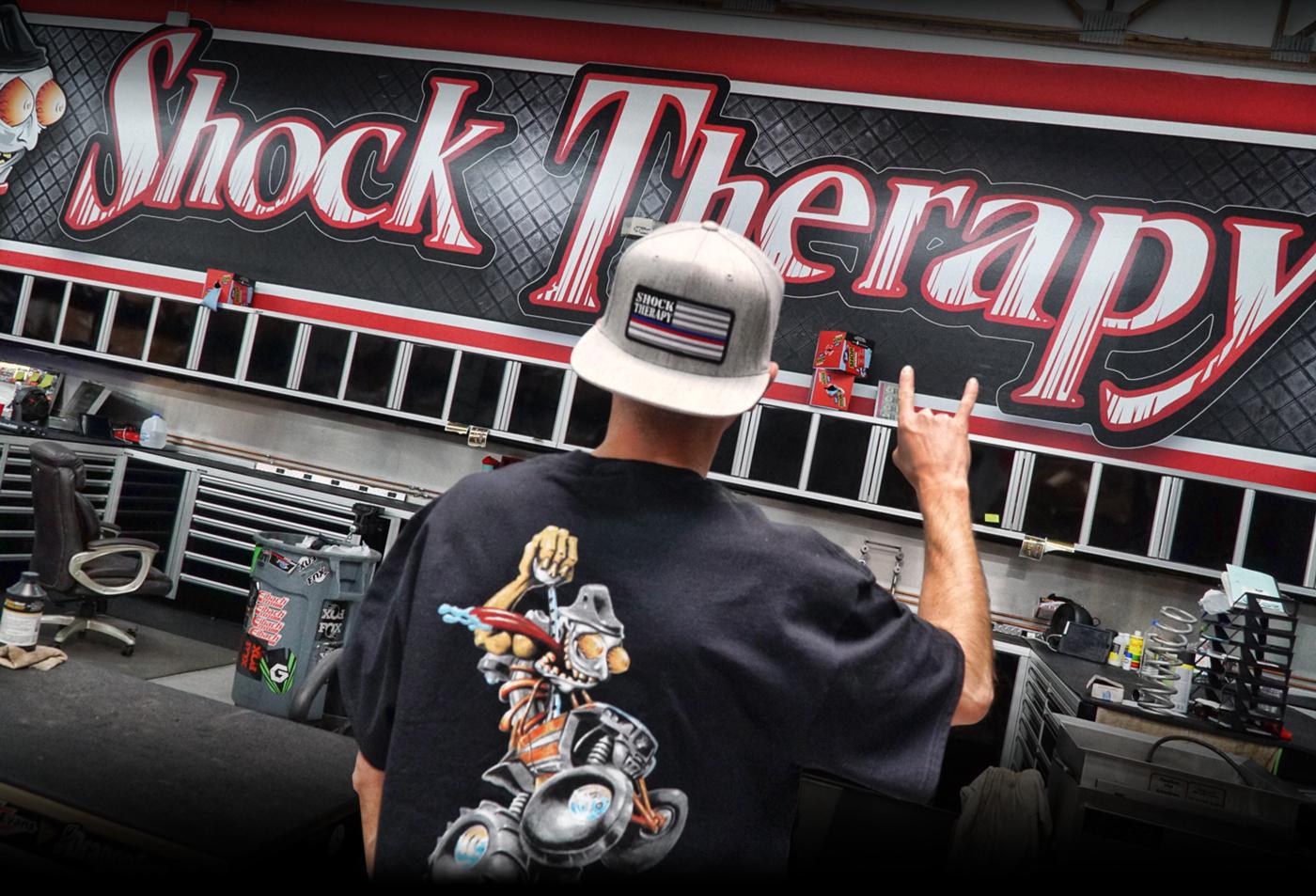
This Arizona-based off-road suspension specialist has become a powerful ally to UTV and shock manufacturers while winning over racers with extraordinary product development and customer service.
Growing up in Southern California in the 1980s with a father who raced a fuel altered, Mickey Thompson as a neighbor, and So-Cal hot rod legend Pete Chapouris’ son as a classmate, it is no surprise Justin Smith was fixated on “big power.”
“That horsepower thing was just driving me—the need or the want to be in anything that was fast,” he said. “I loved horsepower, period.”
From his teen years rebuilding small block Chevys and Fords to drag racing as a young adult, Smith’s pursuit of speed suddenly went “off-track” in the early 2000s.
“I got a ride in an off-road truck,” he said, “and I never looked back.”
Power still mattered in off-road, but not as much as the ride. So Smith threw himself into learning all he could about suspension as he developed a business building sand rails and other full-size off-road vehicles.
The shock he and many others weren’t prepared for, however, was the Great Recession. He lost everything.
As he battled back, his wife, Jeanette, broke her back in a boating accident, leading to a serendipitous start to Smith’s current business, Shock Therapy LLC, in Phoenix, Arizona, a powerhouse suspension tuning and parts manufacturer that serves the surging UTV market.
“The way this company was started is that she could no longer ride in our UTV because it was too rough and abusive,” he said. “And so I took the shock knowledge from years before in race cars and pre-runners and put a set of Walker Evans shocks on a (Polaris RZR) 900, valved them and sprung them, and made many changes to try to make it super plush.”
It worked. Jeanette could ride again—and still does, 10 hours a day sometimes, even with 2 feet of titanium in her back.
The business name—Shock Therapy—is spot-on for the circumstances, though not planned.
“Actually, the name was just out of the blue, but after I mentioned it, it made perfect sense,” Smith said. “The operation (on his wife), and physically improving shocks.”
The two certainly go hand-in-hand for Shock Therapy. “I think with shocks you adjust rebound until it’s perfect,” Smith said. “In life you can rebound until you succeed.”
Explosive Growth
The modifications for his wife and other early developments took place in the Smiths’ three-car garage, the first official location of Shock Therapy for its formal start as a business in 2014. It has progressed to a complex of three buildings totaling 40,000 square feet, with 14 CNC machines and 60 employees.
The 50-year-old Smith admitted that as he rebounded into the shock and suspension business, there was no Nostradamus forecast.
“The last thing I did was take a look at UTVs and think, ‘That’s going to be the next gold mine,’” he said.
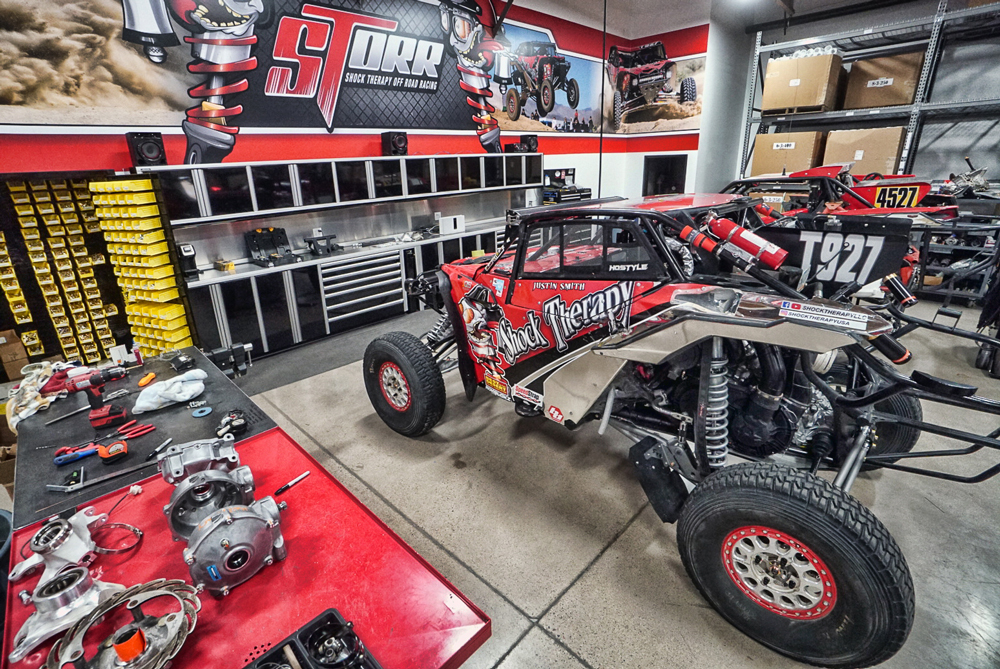
And yet today’s UTV market is “insane,” allowing Shock Therapy to roughly double its gross sales every year to hit $20 million in 2020.
The company manufactures, sells, and services suspension parts and accessories for Can-Am, Honda, Kawasaki, Polaris, Textron, and Yamaha vehicles. Giving attention to the full suspension is necessary when you consider a well-traveled axiom of motorsports: Speed leads to weak points.
“You go faster because you can, then all of a sudden you break radius rods. Ah, we supply those,” Smith said. “Then, if you break the radius rod, the next thing in line is the tie rods go. Well, we supply those. And then the next thing, you destroy the rack and pinion because they’re not strong enough for the big wheels and tires and driving that hard, and we build rack and pinion.”
Today’s inventory of parts belies Smith’s motto of managing growth, but he did just that in Shock Therapy’s early days. “You have to hold back for the inevitable shakeup; 2008 is always in the back of my mind,” he said.
With that, he carries no debt. All equipment, vehicles, and inventory are paid for, which he acknowledged likely slowed the company’s growth, including the employee count, early on.
“But if everything went to hell in a handbasket tomorrow,” he said, “I’ve got $12 million of inventory that’s all paid for.”
Power of CNC
Shock Therapy’s 14 Mazak CNC machines—from a standard lathe to the seven-axis Integrex—perhaps best represent Smith’s unique dichotomy of bold restraint: He’s not afraid to invest, and yet every machine was purchased used, ranging from $30,000 to $250,000 for the Integrex.
“But we’re very, very careful about their past,” he said of the machines.
And, he has stuck with one brand for the similarity in parts and computer language. “Our employees can be trained on one and know how to run them all,” he said.
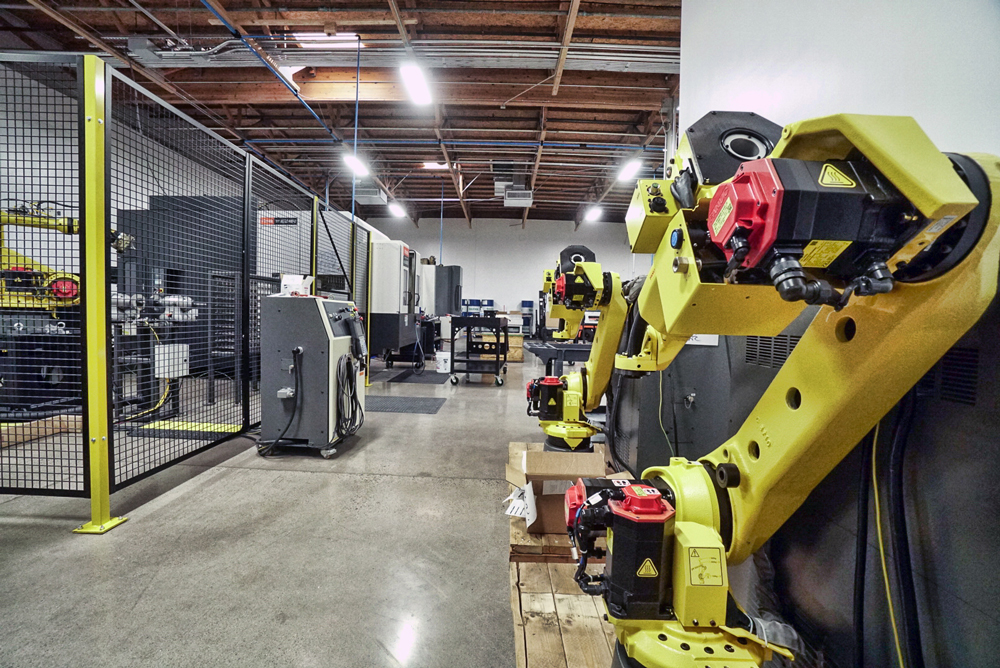
He’s also found, as many others do with high-tech machinery, that he’s not using the Integrex to its full potential, and yet its automation allows production of simple parts without human intervention.
Its versatility is valuable, too. “It has parts going through it as simple as a spacer for a rod end to as complicated as a rack-and-pinion main body,” Smith said.
The CNCs have been vital because they eliminate the middleman in designing parts, and Shock Therapy now has more than 400 part numbers and 24 patents.
Smith conveyed the potential of in-house CNC work through the following story: He was on an airplane waiting for takeoff when he had an idea for a clevis, used to attach a rod end to a rack and pinion for adjustability. He sketched it on a drink napkin, took a picture with his phone, and sent it to his machinist.
“By the time I landed,” he said, “he had sent to my phone a CAD drawing of it, and we were making it that afternoon.”
Free Upgrades
Customers come to appreciate Smith’s proprietary information—“his special sauce”—gleaned through R&D, said Shayne Williams, a longtime customer of Smith’s from Peoria, Arizona. He raced for years but now prefers simply to ride his Can-Am Maverick X3 and custom-built sand rails.
Williams has accompanied Smith on the very long test days he puts in for new parts, “and it’s just brutal,” he said, laughing.
“He tears them apart until he can get them perfect, then tears them apart and makes them go bad the opposite way just to make sure,” Williams said, calling Smith a “geometry whiz. He spends an astronomical amount of time to be sure his stuff is the best that money can buy.”
Customers appreciate that Smith keeps that information—spring rates, valving, rate of oil—in-house, and uses it to develop the specific ride a customer seeks.
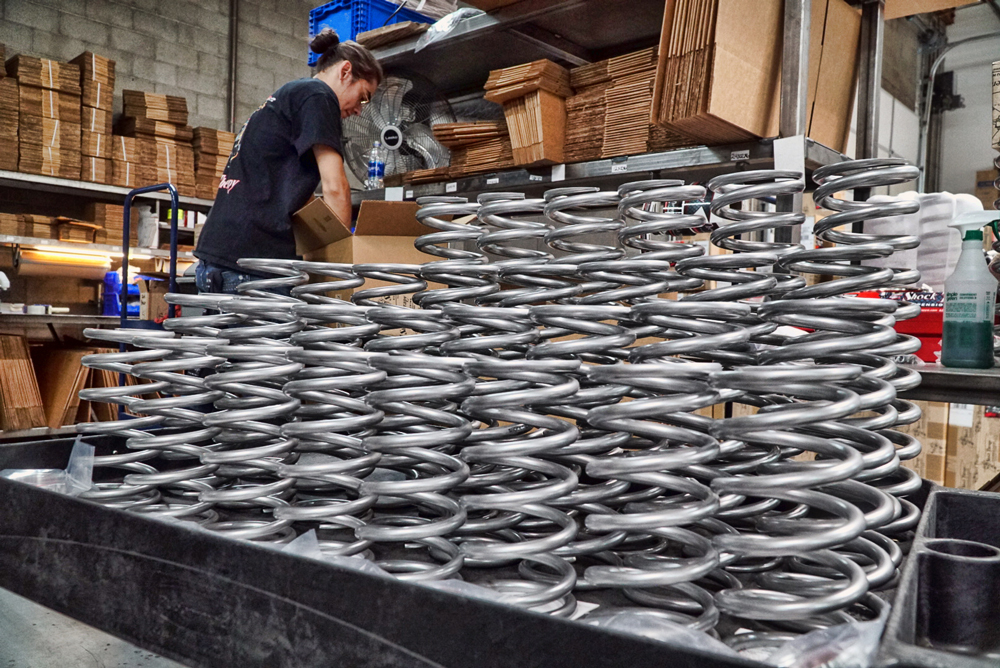
Also valuable—and unusual—is that Shock Therapy, as it improves its products, upgrades customers’ parts for free.
“Who does that? Who calls their customers and says, ‘Let me rebuild it for free,’” Williams asked.
Retired from the fire service and riding a “play car”—a 2021 Polaris RZR Turbo S—in the desert west of Phoenix, John Huppertz has found great value in Shock Therapy’s services.
“I like to be aggressive in my riding, but I like a comfortable ride, too,” he said. “Once I had Shock Therapy revalve and respring my car, it made the ride a lot better, a lot more plush. I’m able to take bumps that if you hit before would be kind of jarring; now you just float over them.”
Huppertz, who chased for a Baja 1000 team in 2019 and will do so again in November, said Shock Therapy refines for the aftermarket the products that OEMs create for the masses.
It leads to the question for Smith: Why not just make your own shocks? “We could build our own shocks, but if we did we’d make enemies (of our partners),” he said.
Instead, Smith said his business is an ally to the shock—and UTV— manufacturers. “We are a business that makes them look better.”
Seeing the Future
UTV manufacturers already use ECU technology, intuitive controls that work on the fly, to affect the suspension. “You turn left it stiffens the right shock,” for example, Smith said.
He raved about Fox’s iQS (intelligent Quick Switch) electronically controlled suspension and what it did for the market. Advanced as it is, however, iQS now represents just the tip of the iceberg. “It doesn’t have to wait for sensors to tell it what to do,” he said. “It knows what’s coming.”
Such terrain-following technology to spot a whoop or potential full-compression “G-out” is not unlike automatic braking or lane departure warning systems in today’s street vehicles, Smith said, and it will further help make UTV rides “amazing.”
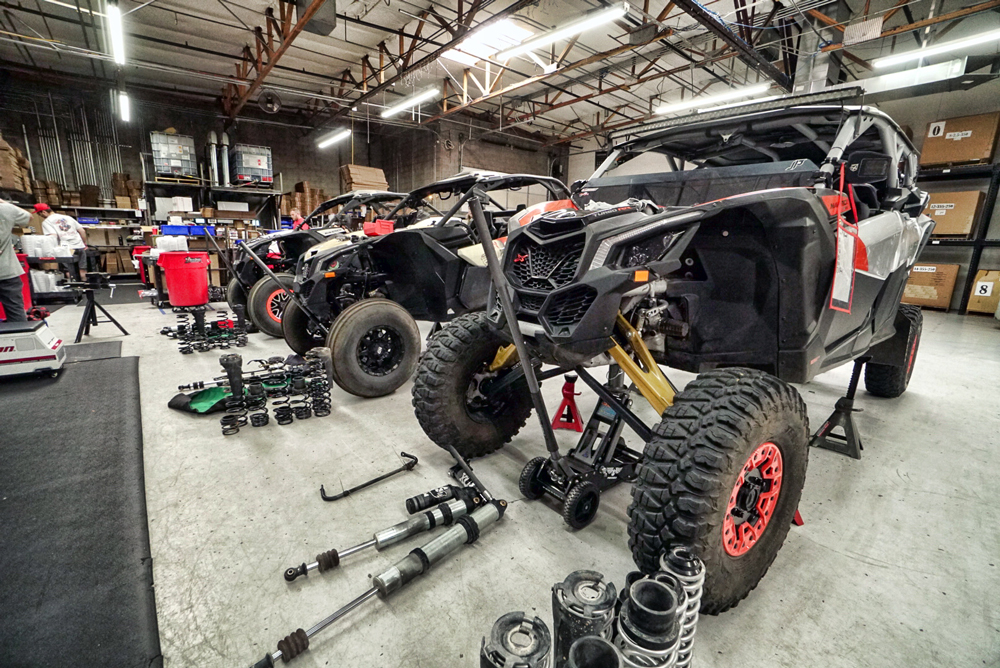
It’s no pipe dream, either, he said in announcing that Shock Therapy late this year will offer a phone app where riders can pay for a suspension tune, not unlike what can already be done for an engine tune.
“We’ve already done the work to make it ride better, but now they can buy the app and do everything on the fly and make it more ‘them,’” Smith said. “You can do it via Bluetooth when you get to where you’re riding. If you’re in the rocks, you put in your rock tune. If you’re in the dunes, you put in your dune tune. If you’re going to go racing or ripping with your buddies, you’ve got aggressive or desert fast.”
Opportunities Abound
Smith said no matter the racing business, new development is the secret to surviving, especially in uncertain economic times. “The opportunity is there for the grasping for those who continue to develop, test, and innovate new products,” he said.
As with other parts for competitive vehicles, suspension sales can be difficult until the customer experiences the advantage firsthand. “It’s hard to get someone to spend money on that magic box; they’re paying for air—until they ride in it,” Smith said. “As soon as their friends have it, or somebody beats them through the rough—then it’s over.”
So it’s still about speed, but perhaps not like it used to be for Smith. “You can put all the power into it you want,” he said about a vehicle, “but if you can’t stop, if you can’t go through the woods, if you can’t hook a corner, it’s pointless.”
What Resume?
–
Justin Smith wasn’t going to do it the same way this time.
“In the past, in all of my other businesses, I hired according to a resume and experience,” he said. “That failed.
“You hire the best guy, but if he’s a bad apple among 10 others—you have 10 other pissed-off guys,” he said. “It was a lot of babysitting.”
This time around, when founding Shock Therapy, he ignored resumes and hired personalities. “We chose the coolest guys we could find, the nicest people we could find, that got along with others, and then we just trained them,” he said.
Today he manages all 60 without an HR person.
Videos shot in the shop show a lot of energy and fun, plenty of ribbing. Passion.
“They all know how to talk smack,” Smith said, laughing. “But one thing they do know to take serious,” he quickly added, “is you pull your own weight, or you get called on it.”
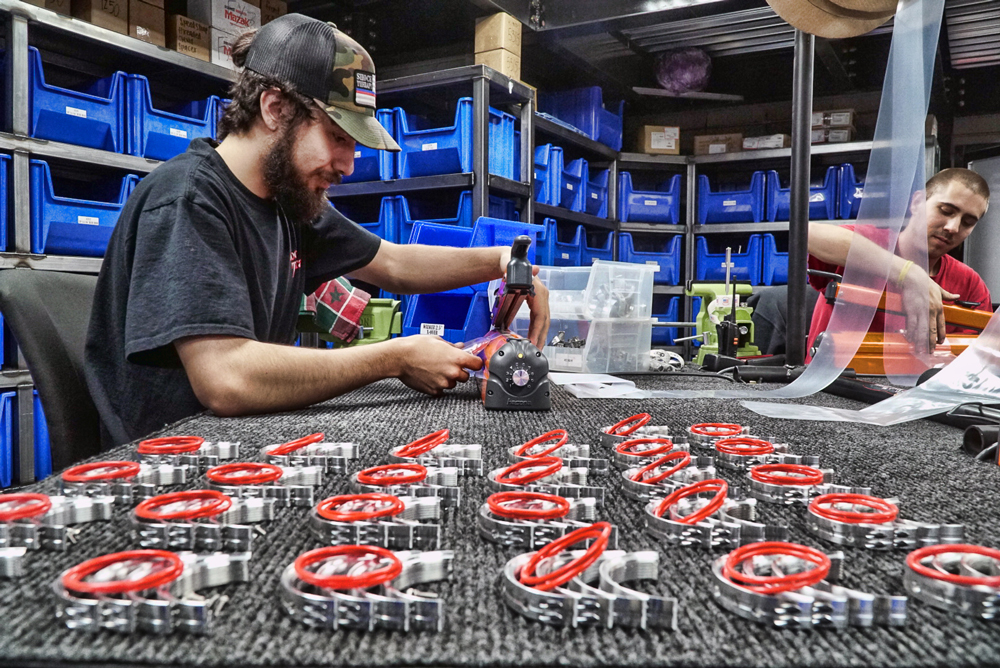
Shock Therapy’s website and social media exude energy. A slow-motion video of a UTV ripping through whoops is mesmerizing. Smith claimed he could watch it all day.
His unique approach has been successful in driving development through his employees. It’s not something one or two people can accomplish, he said.
“We’re nothing without our crew,” Smith said. “Our guys are badass, and they’re the reason we get things done every day, and get them done right.” —Andy Heintzelman
 MEMBERSHIP LOGIN
MEMBERSHIP LOGIN JOIN PRI
JOIN PRI


